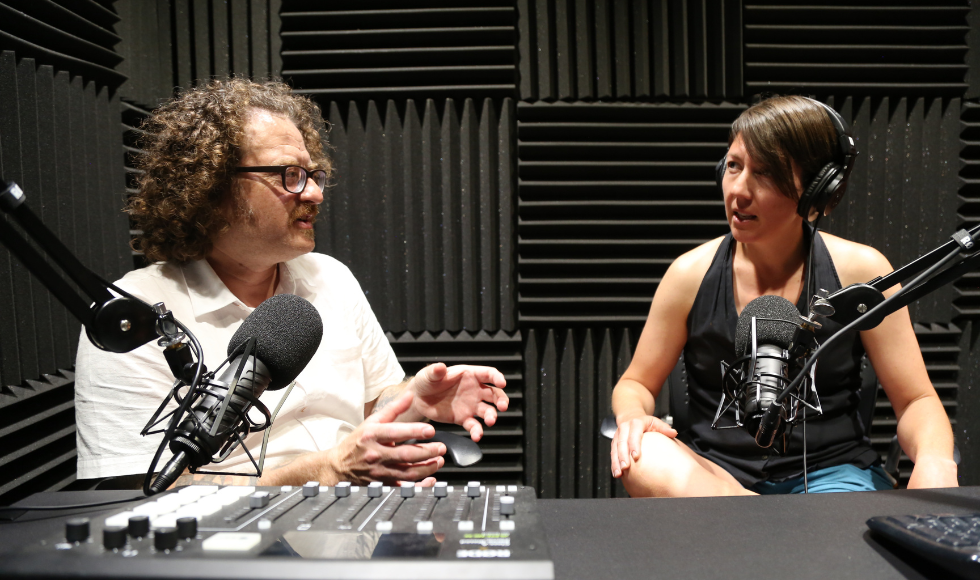McMaster develops and shares open resources on using generative AI in education

AI Dialogues podcast host Stephanie Verkoeyen, right, from McMaster's MacPherson Institute, discusses generative AI with Ian Steinberg, editorial manager for the International Journal for Students as Partners. The podcast is just one part of McMaster's robust toolkit of generative AI resources, which are being adopted by more and more institutions.
As the uses — and risks — of generative Artificial Intelligence in education continue to evolve, an increasing number of institutions are drawing on new open-access resources developed at McMaster for guidance on the appropriate use of AI for students and instructors.
This summer, McMaster released revised teaching and learning guidelines, which offer clearer direction on areas such as the potential risks of using AI in learning, AI detection tools, and appropriate uses of AI for students and instructors.
The Paul R. MacPherson Institute for Leadership, Innovation and Excellence in Teaching at McMaster has also developed several free, publicly available resources to support educators outside McMaster as they work with this rapidly evolving technology.
“We have adapted several resources from McMaster,” says Sara Fulmer, acting director for the Office of Teaching and Learning at the University of Guelph.
“Our office looks to McMaster as leaders in generative AI and teaching and learning, and in developing comprehensive and valuable resources for faculty, instructors, staff, and students on gen AI.”
Fulmer points to the pressbook Generative AI in Teaching and Learning: “The section on designing assessments has been particularly useful because that’s the main area of concern and uncertainty for faculty,” she says.
“We continue to share this resource and have adapted sections of it for our own workshops and resources.”
McMaster has made its resources open-access, leading to more thoughtful development and rapid improvement of materials as institutions share learnings.
“Over the past year we’ve also met with Dalhousie University, University of Toronto, Simon Fraser University, as well as the Higher Education Quality Council of Ontario and the Ontario Council of Graduate Studies, to share what has worked and not worked for us,” says Erin Aspenlieder, special advisor to the provost on generative AI.
“Those conversations are so beneficial because we can learn what opportunities and challenges other institutions are encountering as well.”
A toolkit for AI in teaching and learning
The revised teaching and learning guidelines are part of a growing collection of resources McMaster offers.
The MacPherson Institute’s Generative Artificial Intelligence in Teaching and Learning webpage provides educators with guidance on thoughtfully integrating AI in teaching.
Among the open resources available are
- The AI Dialogues Podcast, featuring conversations with educators, students and academic staff on the ethical and practical use of AI in education
- The Assessment Partner, a unique resource that uses generative AI to help instructors develop custom assessments for their courses.
“AI has a lot of potential uses in course and assessment design, but the process of interacting with it can be messy and frustrating,” says Fulmer, from the University of Guelph.
The Assessment Partner tool lessens that learning curve by providing a structure and key prompts, Fulmer says.
“We demonstrated [it] during a recent workshop on designing assessments with gen AI, and our instructors were really excited about it.”
The tool was developed by Fazmin Nizam, a staff member in the Faculty of Engineering, in partnership with the MacPherson Institute.
Nizam has a background in software engineering and served on McMaster’s Generative AI Task Force. He refined Assessment Partner in collaboration with Aspenlieder; Stephanie Verkoeyen, educational developer at the MacPherson Institute; and Benjamin Taylor, academic skills program coordinator with the Student Success Centre.
The Assessment Partner allows educators to create a student assessment by selecting from several options to set the parameters of their evaluation. Its framework deploys multiple AI agents with specific roles, then generates an assessment that includes learning objectives, format guidance, assignment tasks, evaluation criteria and more.
It also leverages different pedagogy models to ensure assessments are rooted in a solid academic approach.
“By cutting out a mundane task, instructors save some time, which translates to a substantial benefit for students,” Nizam says. “It provides instructors with more chances for one-on-one interaction, which is an irreplaceable part of teaching.”
Educators will need to learn how to meaningfully bring this new technology into the classroom to assist with improving the learning experience, says Aspenlieder, who is also working with non-academic campus units to help develop considerations and guidance on the use of AI.
“An expert educator brings thoughtful design and a curated learning experience to students,” she says.
“Sure, an AI could create a course outline and a module for a student to complete, but that subject matter expert or ‘human in the loop’ who can validate, verify, interpret, explain and coach the student really matters.”

